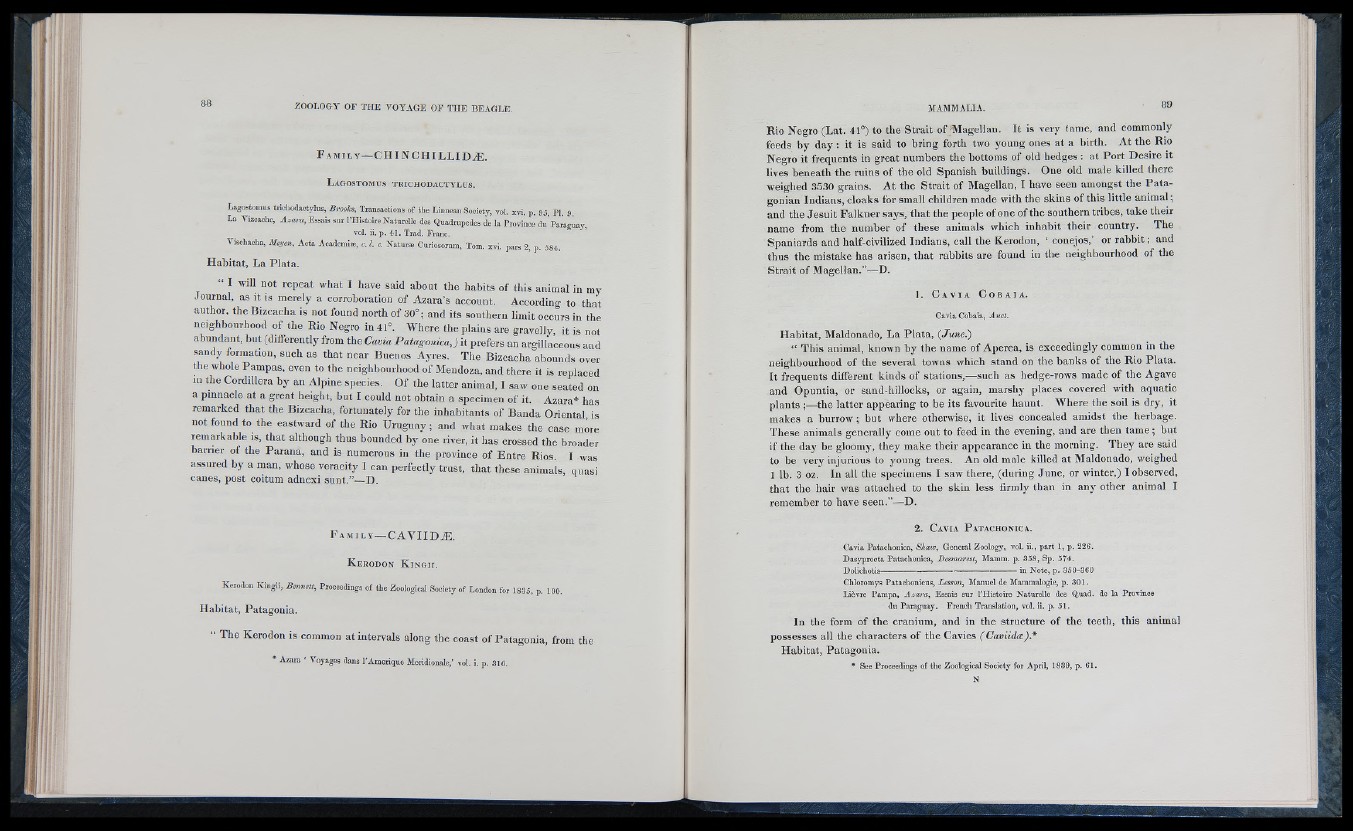
F a m i l y — C H IN C H IL L ID iE .
L a g o s t o m u s t r i c h o d a c t y l u s .
Lagostomiis trichodactylus, B ro o b , Trausacliona of the Liuuean Society, vol. xvi. p. 95 PI g
La Vkcachc, A za m , Essais sur I’H istoiie N.aturelle des Quadrnpedes de la Pioviucc du’paraguay,
vol. ii. p. 41. Tr.ad. Franc.
Vischacha, Mcy»,, A cta Aoademlui, c. Í. c. N a tu re Curiosorum, Tom. xvi. p.ars 2, p. 584.
Habitat, La Plata.
“ I will not repeat what I have said about the habits of this animal in my
.lournal, as it is merely a corroboration of Azara’s account. According to that
author, the Bizcacha is not found north of 30°; and its southern limit occurs in the
neighbourhood of the Rio Negro in 41°. Where the plains are gravelly, it is not
abundant, but (differently from the Cavia Patagónica,) it prefers an argillaceous and
sandy formation, such as that near Buenos Ayres. The Bizcacha abounds over
the whole Pampas, even to the neighbourhood of Mendoza, and there it is replaced
in the Cordillera by an Alpine species. Of the latter animal, I saw one seated on
a pinnacle at a great height, but I could not obtain a specimen of it. Azara* has
remarked that the Bizcacha, fortunately for the inhabitants of Banda Oriental is
not found to the eastward of the Rio Uruguay; and what makes the case mm'e
remarkable is, that although thus bounded by one river, it has crossed the broader
barrier of the Parana, and is numerous in the province of Entre Rios I was
assured by a man, whose veracity I can perfectly trust, that these animals, quasi
canes, post coitum adnexi sunt.”—D.
F a m i l y — C A V II D ^ .
K e r o d o n K i n g i t .
KerodoE K ingii, Bennett, Proceedings of the Zoological Society of London for 1835, p. 190.
Habitat, Patagonia.
“ The Kerodon is common at intervals along the coast of Patagonia, from the
* Azara ‘ Voyages dans I’Amerique Meridionale,’ vol. i. p. 316.
Rio Negro (Lat. 41°) to the Strait of Magellan. It is very (ame, and commonly
feeds by day : it is said to bring forth two young ones at a birth. At the Rio
Negro it frequents in great numbers the bottoms of old hedges : at Port Desire it
lives beneath the ruins of the old Spanish buildings. One old male killed there
■weighed 3530 grains. At the Strait of Magellan, I have seen amongst the Patagonian
Indians, cloaks for small children made with the skins of this little animal;
and the Jesuit Falkner says, that the people of one of the southern tribes, take their
name from the number of these animals which inhabit their country. The
Spaniards and half-civilized Indians, call the Kerodon, ‘ conejos,’ or rabbit; and
thus the mistake has arisen, that rabbits are found in the neighbourhood of the
Strait of Magellan.”—D.
1. C a V IA C o b A i A .
Cavia Cobaia, Auct.
Habitat, Maldonado, La Plata, (June.)
“ This animal, known by the name of Aperea, is exceedingly common in the
neighbourhood of the several towns which stand on the banks of the Rio Plata.
It frequents different kinds of stations,—such as hedge-rows made of the Agave
and Opuntia, or sand-hillocks, or again, marshy places covered with aquatic
plants ;—the latter appearing to be its favourite haunt. Where the soil is dry, it
makes a burrow ; but where otherwise, it lives concealed amidst the herbage.
These animals generally come out to feed in the evening, and are then tam e; but
if the day be gloomy, they make their appearance in the morning. They are said
to be very injurious to young trees. An old male killed at Maldonado, weighed
1 lb. 3 oz. In all the specimens I saw there, (during June, or winter,) I observed,
that the hair was attached to the skin less firmly than in any other animal I
remember to have seen.”—D.
2 . C a v i a P a t a c h o n i c a .
Cavia Patachonica, S Im c, General Zoology, vol. ii., part 1, p. 226.
Dasyprocta Patachonica, Desmarest, Slamin. p. 358, Sp. 574.
Dolichotis--------------------------------------------------------in Note, p . 359-360
Chloroniys Patachonicus, Lesson, Manuel de Mammalogie, p. 301.
Lièvre Pam pa, A za ra, Essais sur n iisto irc Naturelle des Quad, de la Province
du Paraguay. French Translation, vol. ii. p. 51.
In the form of the cranium, and in the structure of the teeth, this animal
possesses all the characters of the Cavies (Caviidoe).*
Habitat, Patagonia.
* See Proceedings of the Zoological Society for April, 1839, p. 61.